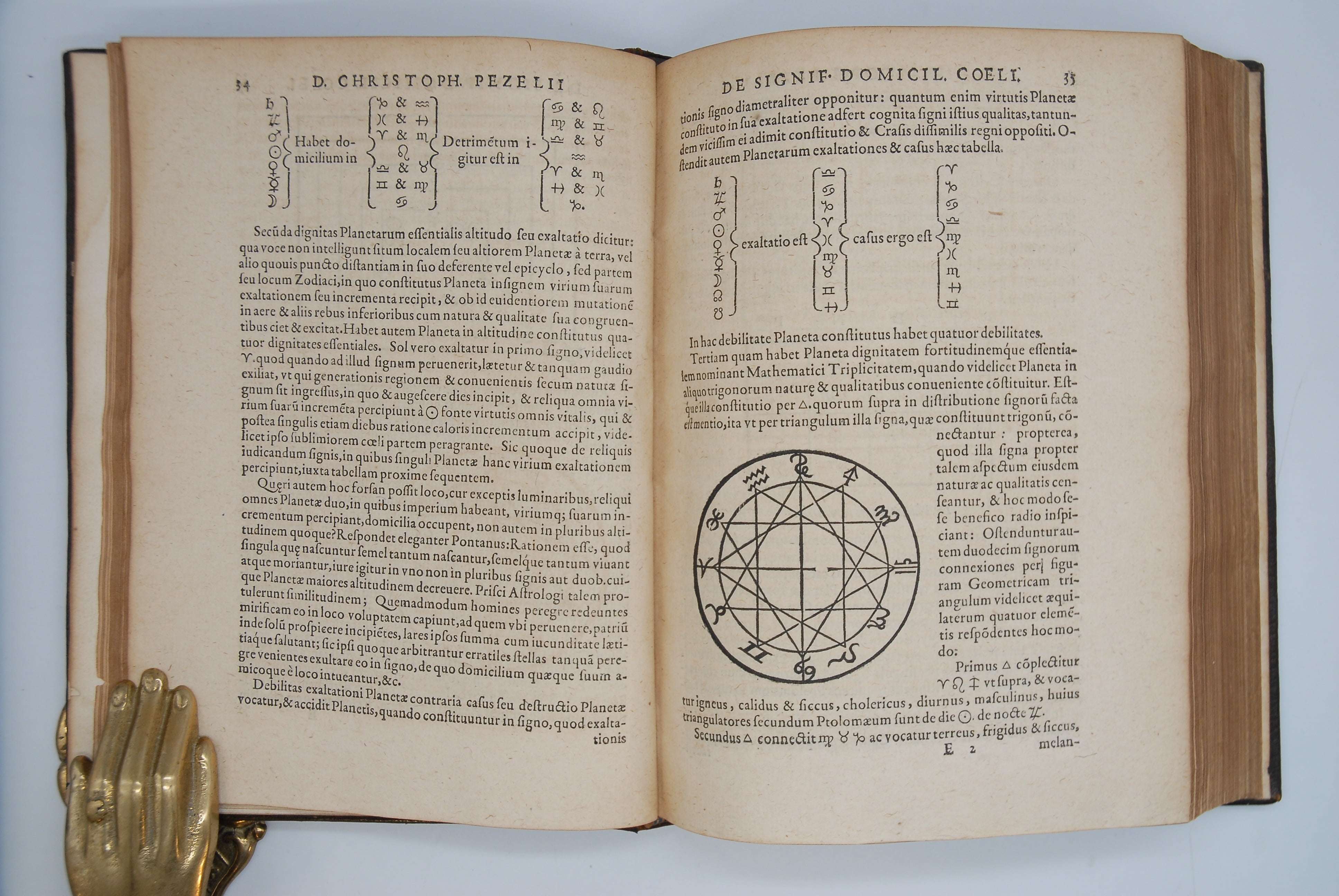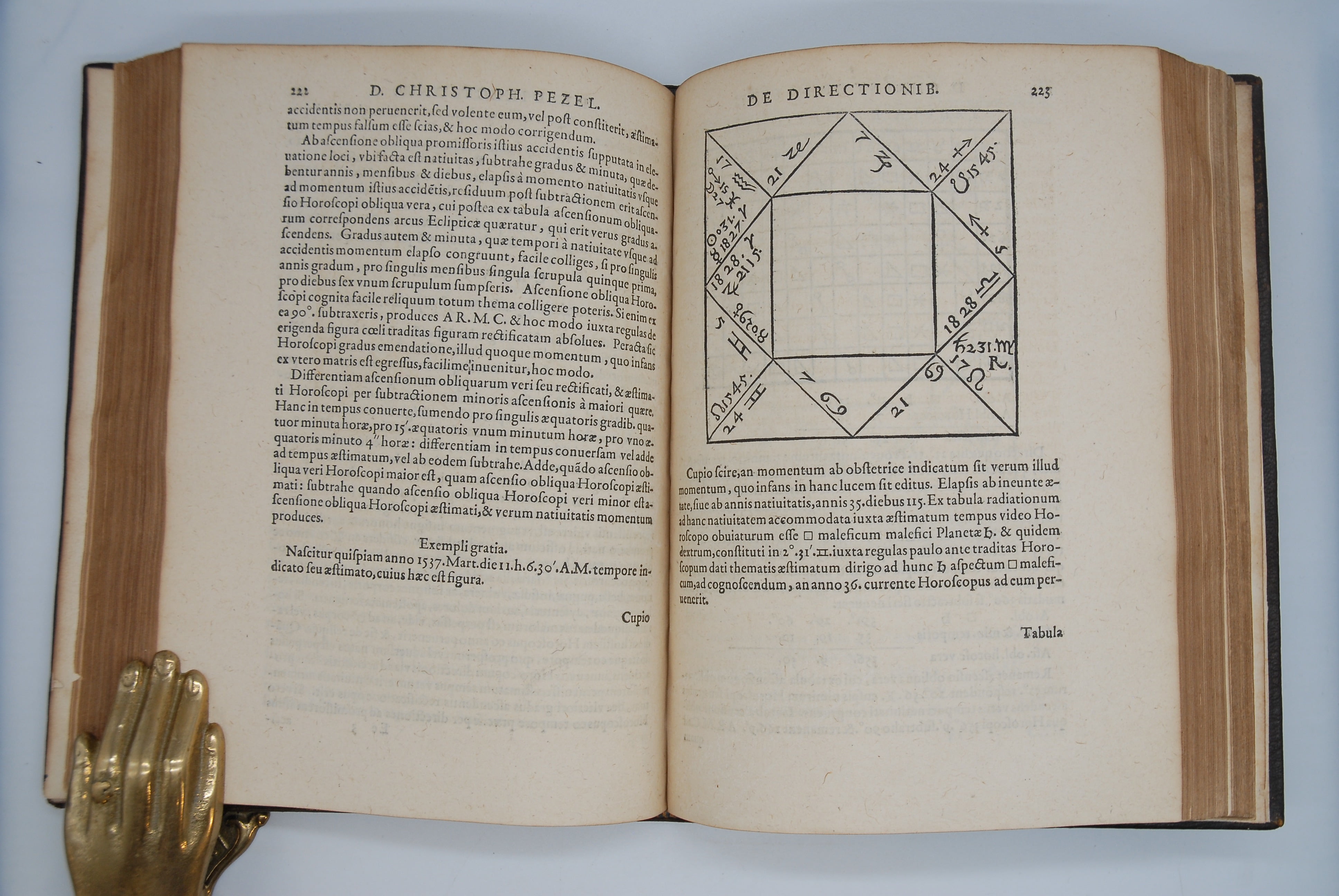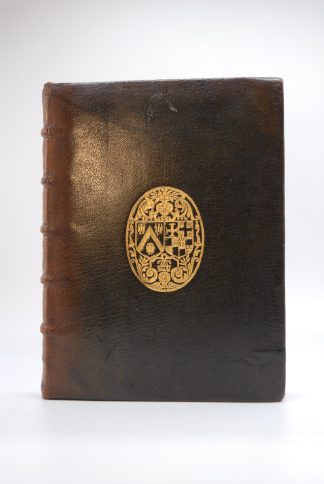PEZEL, Christoph [with] CAMERARIUS, Johann Rudolph [and] TANNER, Adam.
BOUND FOR DE THOU
Praecepta genethliaca, sive de prognosticandis hominum nativitatibus
£9,750.00
PEZEL, Christoph. Praecepta genethliaca, sive de prognosticandis hominum nativitatibus
CAMERARIUS, Johann Rudolph. Horarum Natalium Centuria Una, sive Narratio Historica
Frankfurt, Wolfgang Richter, Johann Theobald Schönwetter and Konrad Meul, 1607 [with]
TANNER, Adam. Astrologia Sacra
Ingolstadt, Elisabeth Angermaier, 1615
FIRST EDITIONS. 4to, 3 works in one, pp. (viii) 227 (i); 124; (viii) 64. Roman letter, astrological symbols, woodcut floriated and historiated initials, decorated headpieces, tailpieces and typographical ornaments. First t-p within ornate engraved border, several astrological tables and calculations in first work, 100 horoscope diagrams in second. Light age yellowing, old repair to one lower outer corner, small paper flaw hole to one fol. affecting a few words, small rust mark to one lower blank margin. A very good copy, beautifully bound in contemporary French morocco, gilt arms of Jacques Auguste de Thou (1553-1617) and his second wife Gasparde de la Chastre to covers, spine with gilt raised bands, de Thou’s and de la Chastre’s monogram and titles gilt in compartments, a.e.g. Modern bookplate ‘C.M.P’ of Charles-Maurice de Pourtalès.
The elegant armorial binding bears the arms of the French politician, historian and bibliophile Jacques Auguste de Thou (1553-1617) joined with those of his second wife, Gasparde de la Chastre. The monogram contains their initials interlaced. De Thou served Henry III and Henry IV as councillor of state, became director of the royal library in 1593 and president of the Parliament of Paris in 1595. His outstanding library, famous among contemporaries and open to scholars and foreigners, was one of the most important private libraries of the end of the 16th century, for the quality of its content and its size (it contained an estimated number of 9,000 volumes in 1617). Remarkably, for the first time, the volumes were systematically bound in rich armorial bindings, changing according to the marital status of their owner. After de Thou’s death, the library was inherited by his son Jacques-Auguste II de Thou in 1642.
The volume contains excellent copies of the first editions of three fascinating works on astrology. The first, ‘Praecepta genethliaca’ is a treatise by the reformed theologian Christoph Pezel (1539-1604). It examines the twelve astrological houses of the horoscope (corresponding to the twelve signs) – with particular focus on the sixth, concerned with illness – and it contains a section on the history of astrology and prediction. The engraved title page, possibly realised by Theodore de Bry or one of his school, has been defined as ‘one of the most delightful in the early astrological books […] Beginning at the upper left and following around counter-clockwise are small vignettes showing first Mars, the planet and the two signs Aries and Scorpio, which it rules; next is Jupiter with the signs Sagittarius and Pisces; then Saturn with Aquarius and Capricorn. Centered below is an interesting heraldic device supported by angels; then comes the Moon with Cancer; followed by Mercury with Gemini and Virgo. At the upper right is Venus with Taurus and Libra. The design at the center above is the Sun accompanied by the sign of Leo.” (Hall)
The second work is the physician Johann Rudolph Camerarius’s (b.1588) attack against false astrologers. It illustrates the principles of the ‘true science’ of astrology through 100 horoscope diagrams identifying the celestial birth coordinates of (mainly German) royal, aristocratic and political figures as well as unknown people who had been his patients and even his own family members. Interesting is the case of two twins who died shortly after birth, in 1606, due to epilepsy. The third work is a collection of five academic ‘Orationes’, ‘Disputationes’ and ‘Quaestiones’ on astrology, astronomy and superstition, discussed at the University of Ingolstadt in 1514. The academic debates were chaired by the Austrian Jesuit theologian Adam Tanner (1572-1632), author of the first and third orations. The second ‘oratio’ is by the theologian Otho Heinrich Bachmair against judicial astrology, and a ‘quaestio’ by Friedrich Pirchinger discusses whether astronomical phaenomena are to be considered ‘prodigia’. In the final section, the Jesuit philosopher Simon Felix answers negatively to Pirchinger’s ‘quaestio’.
1) USTC 2027422; VD17 23:287237B; BM STC Ger 17th century, P507; Graesse V, p. 247; Houzeau-Lancaster 5033; Cantamessa N. 6067. Not in Brunet. 2) USTC 2014390; VD17 23:287241N; BM STC Ger 17th century, P507; Cantamessa N. 1355; Houzeau-Lancaster 5047; Wellcome I, 1230; Not in Brunet or Graesse. 3) USTC 2108093; VD17 23:238787Z; BM STC Ger 17th century, T61; Cantamessa N. 7855; Not in Brunet, Graesse or Houzeau-Lancaster. M.P. Hall, Astrological Bibliography, PRS Journal 46/2 (1986).In stock









